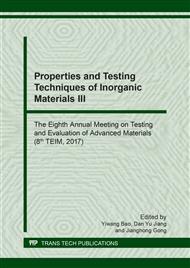[1]
S.Z. Zhao, B.K. You, Control technique and application of cracking resistance of shrinkage compensating concrete , China Building Industry Press, Bei Jing, (2010).
Google Scholar
[2]
L.Y. Ma, Y. Yao, P. Tian, L. Wang, L.Z. Shang, X. D. Jia, Review of experimental and research methods on shrinkage and cracking resistance of concrete at home and abroad, China building materials science & technology, 1(2001) 27-31.
Google Scholar
[3]
Commission of the European Communities, Design of concrete structures, Structural Fire Design, European, (1990).
Google Scholar
[4]
J.Z. Xiao, Y.B. Huang, H.M. Ren, Influence factors and theoretical techniques of concrete thermal parameters, Fly ash, 5(2008) 17-20.
Google Scholar
[5]
Y.C. Zhang, J.M. Li, L.L. Gao, Effect of coarse aggregate on cement concrete thermal parameters, Journal of changsha university of science and technology (natural science), 9(2012)37-41.
Google Scholar
[6]
X.Y. Huang, H.S. Shi, Research progress of hydration heat in cement and concrete, Cement technology, 6(2009)21-26.
Google Scholar
[7]
Z.Y Ren, L.J. Wang, S.P. Yin, Analysis of hydration heat and crack-resistance of high fly-ash concrete, Concrete, 5(2002)18-20.
Google Scholar
[8]
Z.W Wu, H.Z. Liang, High performance concrete, China railway publishing house, Bei Jing,(1999).
Google Scholar
[9]
Y.S Zhang, W. Sun, S.F Liu. Study on the hydration heat of binder paste in high -performance concrete, Cement and Concrete Research, 32 (2002) 1438-1448.
DOI: 10.1016/s0008-8846(02)00810-4
Google Scholar
[10]
B.X. Li, W.Q. Liang, Z. He, Study on high-strength composite portland cement with a larger amount of industrial wastes, Cement and Concrete Research, 32(2002)1341-1344.
DOI: 10.1016/s0008-8846(02)00804-9
Google Scholar
[11]
L. Li, W.D. Liu, Q.T. Li, G.L. Zhao, An experimental study on thermal conductivity of air entraining concrete, Journal of hebei university of engineering (natural science edition), 28(2011)17-20.
Google Scholar


